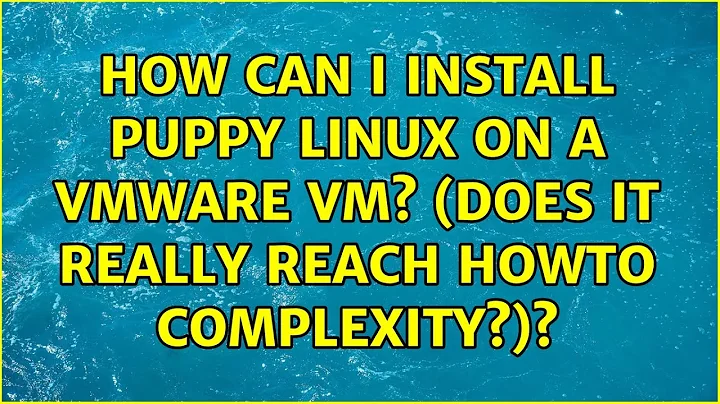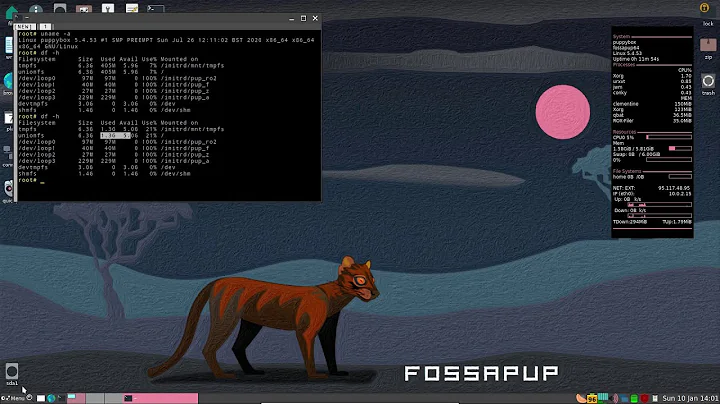How can I install Puppy Linux on a VMware VM? (Does it really reach HOWTO complexity?)
Puppy linux and derivatives seem not to recognize SCSI disks from ESXi so you have just to connect an IDE virtual or physical disk (change the SCSI interface in vsphere client and attach an IDE disk).
If it still don't see the disk I try a more modern live cd,create and format partitions in some ext varient or fat system and reboot in puppy.
Related videos on Youtube
Christos Hayward
Jonathan Hayward is a recovering geek. He holds master's degrees bridging math and computer science (UIUC) and philosophy and theology (Cambridge), and is considered to be in the profoundly gifted range. He is presently learning Node and Russian. Read full biography—it's interesting.
Updated on September 18, 2022Comments
-
Christos Hayward over 1 year
I am trying to install an Ubuntu-compatible Puppy Linux VM, and am concerned that this looks like the most difficult VMware Linux installation I've seen yet. I've seen http://johann.loefflmann.net/en/articles/how-to-install-puppy-linux-3.01-on-vmware.txt (which points to an FTP site that is live but does not, after a couple of clicks, show to download the preferred ISO -- is the lupu-528.005.iso I downloaded from elsewhere appropriate?), and a couple of in-depth, hacker-strength HOWTO's, which may or may not point to something current in their URL's, but I haven't been able to follow any of them to the point of installing on a working system.
(I can boot off the live ISO image just fine; I haven't yet managed to get it to talk to the VMware virtual hard drive partition.)
Is getting Puppy to install on a VMware VM really at a Linux guru's HOWTO in pay grade? Is there a simple way I can install Puppy to a hard drive, whether or not it's at the point-and-almost-drool simplicity of almost every other Linux distribution I've tried to install?
-
 fixer1234 almost 7 yearsThis is an old thread, but let me ask a dumb question. Puppy can be installed, but it's designed to operate simply as a live session with persistence. Did you look at just running it that way from the VM rather than trying to install it?
fixer1234 almost 7 yearsThis is an old thread, but let me ask a dumb question. Puppy can be installed, but it's designed to operate simply as a live session with persistence. Did you look at just running it that way from the VM rather than trying to install it? -
Christos Hayward almost 7 yearsI recognize that a Puppy Linux is more often booted from USB than internal hard drive, but Puppy has another use case that interests me: being able to make (and share by letting other people download) an appliance that is demands as little as feasible on host computers that may or may not be particularly powerful. There's got to be another solution for this use case that's 1%-5% leaner, but Puppy is the best major Linux distribution to make an appliance with as light a touch as possible. A VM can be can be distributed where a USB key can't quite as easilly be sent to everyone who wants one.
-
 fixer1234 almost 7 yearsI didn't explain my suggestion well; what we're each saying isn't mutually exclusive. My suggestion was to treat the VM like a removable drive in the way you write the ISO to it, rather than trying to install Puppy on the VM. With Puppy, writing the ISO to an optical disc or flash drive isn't like most other Linux distros. In other distros, that action yields installation media, which may also act as a limited live demo. With Puppy, that live demo is the full, operational version that works the same as if you then install it. Simply burning the ISO to the VM might avoid some of the problems.
fixer1234 almost 7 yearsI didn't explain my suggestion well; what we're each saying isn't mutually exclusive. My suggestion was to treat the VM like a removable drive in the way you write the ISO to it, rather than trying to install Puppy on the VM. With Puppy, writing the ISO to an optical disc or flash drive isn't like most other Linux distros. In other distros, that action yields installation media, which may also act as a limited live demo. With Puppy, that live demo is the full, operational version that works the same as if you then install it. Simply burning the ISO to the VM might avoid some of the problems.
-
-
Christos Hayward almost 10 yearsI tried that before I posted. I couldn't get it to see the virtual drive.
-
Christos Hayward almost 10 yearsThe instructions say "Install to H.D.D. using Menu > System > Puppy Universal Installer". I clicked on "Menu", navigated to "System", and failed to find any item under that submenu or the "System Status and Config" subsubmenu called "Puppy Universal Installer."
-
Julian Knight almost 10 yearsMight not appear if it cant "see" the drive? I assume that the drive is mounted to mountpoint
/? Do you also have a SWAP mount point? Those are usually the 2 minimum mounts you need to do an install of Linux. (Sorry if that is stuff you already know). -
 Scott - Слава Україні almost 7 yearsCould you please translate this into English? Or, better yet, answer the question (in English).
Scott - Слава Україні almost 7 yearsCould you please translate this into English? Or, better yet, answer the question (in English). -
 DavidPostill almost 7 yearsI can't work out whether this actually answers the question.
DavidPostill almost 7 yearsI can't work out whether this actually answers the question. -
 RobEl over 6 yearsI've seen this work as a solution before, also changing the SCSI Bus type (BusLogic vs. LSI Logic. vs. IDE). If you can provide more information on your set up, that would help (VMware Player vs. ESXi, version of Puppy and VMware), etc.
RobEl over 6 yearsI've seen this work as a solution before, also changing the SCSI Bus type (BusLogic vs. LSI Logic. vs. IDE). If you can provide more information on your set up, that would help (VMware Player vs. ESXi, version of Puppy and VMware), etc.




